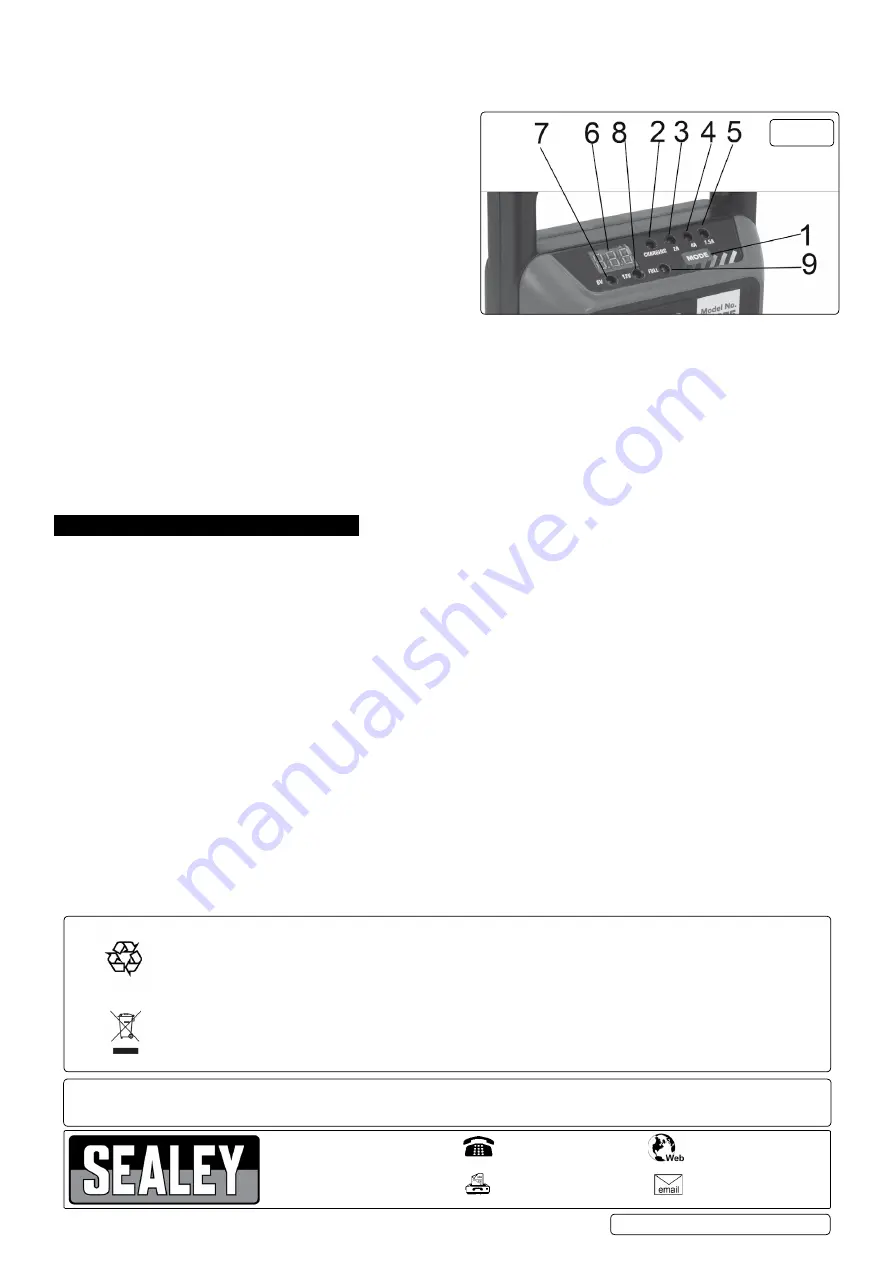
4.3.
the charger is a automatic charger, which means it need not be
disconnect once the battery is fully charged.
the charger can remain
connected to the battery and the charger will automatically stop
charging once the battery is fully charged. it will also resume
charging automatically once the battery needs charging.
4.4.
fig.2
1. charging current selector
2. red light indicates: charging in progress
3. Red light indicates: Load current 2Amp
4. red light indicates: load current 4Amp
5. red light indicates: charging current 7.5Amp
6. Voltmeter
7. Red light indicates: 6V
8. Red light indicates:12V
9. Green light indicates: Battery fully charged
4.5.
charging the battery
4.5.1.
connect the battery to the charger following the connection procedure.
4.5.2.
the battery voltage is selected automatically by the charger. if the battery is discharged or defective, there is a possibility of an
automatic selection error, for example, if a 12 volt battery with a deep discharge has been mistaken for a 6 volt battery, Should this be
the case, test the battery and/or use a standard charger to run a “forced” charge. You can check the battery voltage on the voltmeter
(6) at all times.
4.5.3.
Using the charging current selector (1) select the charging current 2A/4A/7.5A depending on the charging speed and the capacity of
the battery. The desired option is displayed on the LED indicators 3/4/5.
4.5.4.
once the battery is fully charged, the green led indicator (9) will light up, indicating that the battery is now fully charged and will stop
charging automatically.
4.5.5.
You can leave the battery connected to the charger and it will set off the charging automatically when required.
5. maINteNaNce
5.1.
cleaning and user maintenance should be carried out by competent persons.
5.2.
After use and before performing maintenance, unplug and disconnect the battery charger.
5.3.
use a dry cloth to wipe all battery corrosion and other dirt or oil from the battery connectors, cords, and the charger case.
5.4.
ensure that all of the charger components are in place and in good working condition, for example, the plastic boots on the battery
clips.
5.5.
servicing does not require opening the unit, as there are no serviceable parts.
5.6.
All other servicing should be performed by qualified service personnel.
5.7.
if the mains cable is damaged, do not use until repaired.
5.8.
store the charger unplugged, in an upright position. the cord will still conduct electricity until it is unplugged from the mains.
5.9.
store inside, in a cool, dry place.
8
DO NOt
store the connectors clipped together, on or around metal, or clipped to cables. if the charger is moved around the shop or
transported to another location, take care to avoid/prevent damage to the cables, connectors and charger. Failure to do so could result
in personal injury or property damage.
s
DC75 | Issue 1 20/07/16
Original Language Version
© Jack sealey limited
fig.2
NOTE:
It is our policy to continually improve products and as such we reserve the right to alter data, specifications and component parts without prior notice.
ImpOrtaNt:
no liability is accepted for incorrect use of this product.
WarraNty:
Guarantee is 12 months from purchase date, proof of which will be required for any claim.
sole uK distributor, sealey Group.
K
empson Way, Suffolk Business Park,
B
ury st. edmunds, suffolk.
i
P32 7AR
www.sealey.co.uk
sales@sealey.co.uk
01284 757500
01284 703534
environmental protection
recycle unwanted materials instead of disposing of them as waste. All tools, accessories and packaging should be
sorted, taken to a recycling centre and disposed of in a manner which is compatible with the environment.
When the product becomes completely unserviceable and requires disposal, drain off any fluids (if applicable)
into approved containers and dispose of the product and the fluids according to local regulations.
Weee regulations
dispose of this product at the end of its working life in compliance with the eu directive on
Waste Electrical and Electronic Equipment (WEEE). When the product is no longer required, it must be disposed
of in an environmentally protective way. contact your local solid waste authority for recycling information.





















